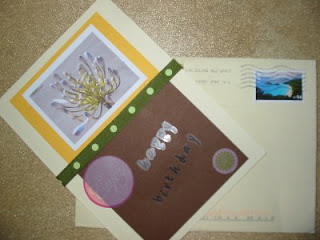Monday, June 30, 2008
Each year my son would drew a card or picture or so in his school for Mother's Day.
And this is what he drew this year. I always wonder why he only drew transportation which is not my flavorite. :P
But this year's card is better than last year one. Thank god!
Labels: Misc
Last Friday, I am surprised to receive a Birthday card from my dear friend - Alvina.
She had made this sweet little card herself. Very sweet and thoughful of her. I can't recall when is the last time I recieve a Birthday card from friend via post. With the advance of technology, which we are so used to it, most time we would just logon to the web and simply send an e-card. I think technology have reduced our human touch alot.
Thanks Alvina for the card.
Below is Alvina's hardwork.
Labels: Misc
Thursday, June 19, 2008
Gotta a few packs of plants' seeds from hubby as a gift.
They are:
1. Cleome spinosa L.
For more info click here
2. Godetia whitney
For more info click here
3. Hssopus officinalis
For more info click here & here
4. Mirabilis jalapa
For more info click here
5. Dahlia pinnata
For more info click here
So you an see your friend here would be busy with planting again. :P
Labels: Plants
Monday, June 16, 2008
Labels: Misc
Labels: Places
Monday, June 9, 2008
FRUIT AS MEDICINE
Morus fruit from Morus alba, the mulberry plant, is often called mulberry fruit. Although there are many species of Morus, the one grown in China is the white mulberry (alba = white). One of the primary uses of the plant is for raising silkworms, which utilize the leaves as their main food source. China has been producing silk since ancient times and remains one of the world's primary sources. The Chinese term for the mulberry plant is sang, and the fruits are known in China as sanshenzi or simply sangshen. The fruit is botanically called a sorosis, because it is formed by the consolidation of many flowers. It is juicy and has a sweet taste with some sourness that is more prominent in the less mature fruits.
Mulberry fruit is classified in the modern Chinese Materia Medica as a blood tonic, and is listed along with herbs having similar traditional uses such as ho-shou-wu (Polygonum multiflorum, root), cooked rehmannia (Rehmannia glutinosa, root), ligustrum (Ligustrum lucidum, fruit) and lycium (Lycium chinensis, fruit). Traditionally, mulberry fruit has been used as a medicinal agent to nourish the yin and blood, benefit the kidneys, and treat weakness, fatigue, anemia, and premature graying of hair. It is also used utilized to treat urinary incontinence, tinnitus, dizziness, and constipation in the elderly and the anemic.
The dominant taste of the ripe fruit is sweet but usually somewhat bland, due to the high water content and low level of other flavoring ingredients, but a richer flavor develops if the fruit is dried; it can then be used as a raisin substitute. In recent years, with considerable work on cultivating the mulberry plants under various conditions, mulberry fruit juice has been commercially produced as a health beverage, and it has become very popular in China, Japan, and Korea. Without adding preservatives, the original juice of mulberry fruit remains fresh under cold storage for 3 months, while the bottled beverage remains fresh at room temperature for 12 months.
As a result of working with the fresh fruits to yield a juice product, the constituents have been analyzed. The main content of fresh, ripe mulberry fruit is:
Water: 85-88%
Carbohydrate (sugars, mainly glucose and fructose, producing the sweet taste): 7.8-9.2%
Protein: 0.4-1.5%
Fat (mainly fatty acids, such as linoleic, stearic, and oleic acids in the seeds): 0.4-0.5%
Free acids (mainly malic acid, producing the sour taste): 1.1-1.9%
Fiber: 0.9-1.4%
Minerals: 0.7-0.9%
Labels: Plants
Tension headaches can be brought on by any number of problems, including bad posture, muscle fatigue, sinus infections, emotional turmoil, high blood pressure, and more. Some migraines, however, can be brought on by food allergies and chemical sensitivities, among other things. Headaches can be a sign of an underlying health condition, so if it is not a tension-type headache, seek professional medical help. If the headaches are of the tension variety, yoga surely can help. Body awareness can help predict the onset of a headache and stop it early in its course. The most common cause of headaches is the forward head position, with rounded shoulders, a curved upper back, and accompanying muscular tension. The first sign of a headache is often a tightening of the shoulders and neck. This contraction causes a reduction in blood flow to the vessels of the head, resulting in a headache.
Yoga poses that can be done at the desk or at home to relieve tension include Garudasana (Eagle Pose) arms to open the space between the shoulder blades, and Gomukhasana (Cow Face Pose) arms to stretch the shoulders. Other poses to experiment with include Setu Bandha (Bridge Pose), Supta Baddha Konasana (Supine Bound Angle Pose), Supported Balasana (Child's Pose), Viparita Karani (Legs up the Wall Pose), and of course, Savasana (Corpse Pose), for total relaxation. In addition, Tomas Brofeldt, M.D., a doctor of emergency medicine with a special interest in headaches at the University of California's Davis Medical Center in Sacramento, recommends repeating the following simple exercises several times a day to prevent headaches:
Extend the arms out, parallel to the floor, palms down. Rotate the palms up. Pull the elbows in toward the torso as you bring the palms to the belly. This aligns the clavicles and scapulae, straightening the upper back.
Stand tall, extending the top of the head up. Pull the chin in with the eyes on the horizon, then bend the head forward. This stretches the back of the neck, adjusting the forward head position.
Sit tall on a chair, with the chin pulled in, and reach the right arm behind, taking the seat back with your hand. Lean the body away diagonally to the left, and with the chin tucked in and dropped, tilt the head left. Place the left hand on the right side of the head and pull gently to stretch. Repeat on the opposite side. A pulling sensation (sometimes uncomfortable in the beginning) should extend from the base of the skull down to the shoulder.
Labels: Exercise









